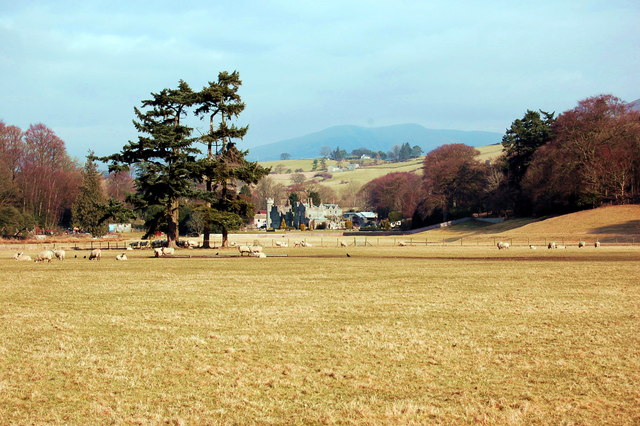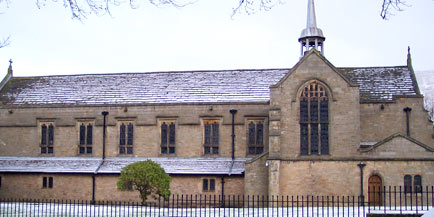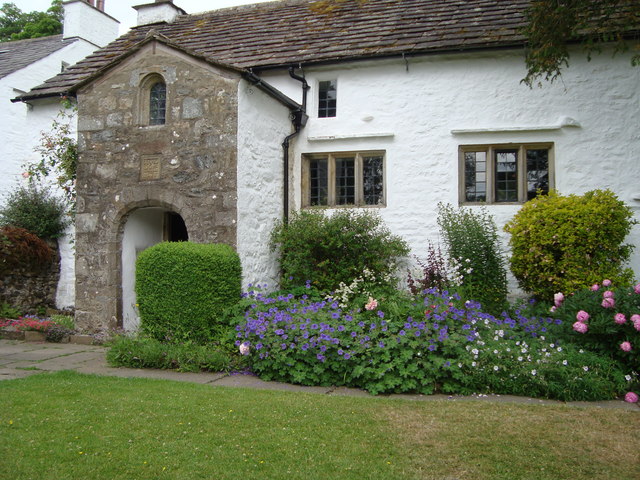|
Sedbergh, Yorkshire
Sedbergh ( or ) is a town and civil parish in Cumbria, England. The 2001 census gave the parish a population of 2,705, increasing at the 2011 census to 2,765. Historically in the West Riding of Yorkshire, it lies about east of Kendal, north of Lancaster and about north of Kirkby Lonsdale, just within the Yorkshire Dales National Park. It stands at the foot of Howgill Fells, on the north bank of the River Rawthey, which joins the River Lune below the town. Situation Sedbergh has a narrow main street lined with shops. From all angles, the hills rising behind the houses can be seen. Until the coming of the Ingleton Branch Line in 1861, these remote places were reachable only by walking over some steep hills. The line to Sedbergh railway station ran from 1861 to 1954. The civil parish covers a large area, including the hamlets of Millthrop, Catholes, Marthwaite, Brigflatts, High Oaks, Howgill, Lowgill and Cautley, the southern part of the Howgill Fells and the western pa ... [...More Info...] [...Related Items...] OR: [Wikipedia] [Google] [Baidu] |
South Lakeland
South Lakeland is a local government district in Cumbria, England. The population of the non-metropolitan district was 102,301 according to the 2001 census, increasing to 103,658 at the 2011 Census. Its council is based in Kendal. It includes much of the Lake District as well as northwestern parts of the Yorkshire Dales. The district was created on 1 April 1974 under the Local Government Act 1972. It was formed from the Kendal borough, Windermere urban district, most of Lakes urban district, South Westmorland Rural District, from Westmorland, Grange and Ulverston urban districts and North Lonsdale Rural District from Lancashire, and Sedbergh Rural District from the West Riding of Yorkshire. In July 2021 the Ministry of Housing, Communities and Local Government announced that in April 2023, Cumbria will be reorganised into two unitary authorities. South Lakeland District Council is to be abolished and its functions transferred to a new authority, to be known as Westmorla ... [...More Info...] [...Related Items...] OR: [Wikipedia] [Google] [Baidu] |
Sedbergh School
Sedbergh School is a public school (English independent day and boarding school) in the town of Sedbergh in Cumbria, in North West England. It comprises a junior school for children aged 4 to 13 and the main school for 13 to 18 year olds. It was established in 1525. History Roger Lupton was born at Cautley in the parish of Sedbergh, Yorkshire, in 1456 and he provided for a Chantry School in Sedbergh in 1525 while he was Provost of Eton.History of the school By 1528, land had been bought, a school built, probably on the site of the present school library, and the foundation deed had been signed. Lupton's subsequent donations to the school's ''Sedbergh scholars'' of numerous scholarships and fellowships to |
Briggflatts
''Briggflatts'' is a long poem by Basil Bunting published in 1966. The work is subtitled "An Autobiography." The title "Briggflatts" comes from the name of Brigflatts Meeting House (spelled with one "g" in Quaker circles), a Quaker Friends meeting house near Sedbergh in Cumbria, England. Bunting visited Brigflatts as a schoolboy when the family of one of his schoolfriends lived there, and it was at this time that he developed a strong attachment to his friend's sister, Peggy Greenbank, to whom the poem is dedicated. It was first read in public on 22 December 1965 in the medieval Morden Tower, part of Newcastle town wall, and published in 1966 by Fulcrum Press."A Basic Chronology" Basil Bunting Poetry Centre''. Accessed 2006-12-01. Bunting also wrote another poem with "Briggflatts" in its title, the short work "At B ... [...More Info...] [...Related Items...] OR: [Wikipedia] [Google] [Baidu] |
Basil Bunting
Basil Cheesman Bunting (1 March 1900 – 17 April 1985) was a British modernist poet whose reputation was established with the publication of '' Briggflatts'' in 1966, generally regarded as one of the major achievements of the modernist tradition in English. He had a lifelong interest in music that led him to emphasise the sonic qualities of poetry, particularly the importance of reading poetry aloud: he was an accomplished reader of his own work.Schmidt, Michael, ''Lives of the Poets'', Weidenfeld & Nicolson, 1998. Life and career Born into a Quaker family in Scotswood-on-Tyne, near Newcastle-on-Tyne, he studied at two Quaker schools: from 1912 to 1916 at Ackworth School in the West Riding of Yorkshire and from 1916 to 1918 at Leighton Park School in Berkshire. His Quaker education strongly influenced his pacifist opposition to the First World War, and in 1918 he was arrested as a conscientious objector having been refused recognition by the tribunals and refusing to comply wit ... [...More Info...] [...Related Items...] OR: [Wikipedia] [Google] [Baidu] |
Briggflatts Meeting House
Brigflatts Meeting House or Briggflatts Meeting House is a Friends Meeting House of the Religious Society of Friends (Quakers), near Sedbergh, Cumbria, in north-western England. Built in 1675, it is the second oldest Friends Meeting House in England. It has been listed Grade I on the National Heritage List for England since March 1954. It is the subject of a twelve-line poem titled "At Briggflatts meetinghouse" by British modernist poet Basil Bunting. Bunting's poem was written in 1975 for the 300th anniversary of the meeting house's construction. Cites the poem as ''Odes II:11, 1975''. Throughout its history, the spelling has varied from ''Brigflatts'', ''Brigflats'', ''Briggflats'', or ''Briggflatts'', for both the village and the Quaker Meeting. Currently, the Quaker Meeting uses the spelling "Brigflatts".SeeBrigflatts Quaker Meeting Retrieved 13 May 2015. The variant spelling with two g's and two t's was used by Bunting for his two poems, "At Briggflatts Meetinghouse" (1975) ... [...More Info...] [...Related Items...] OR: [Wikipedia] [Google] [Baidu] |
Northern England
Northern England, also known as the North of England, the North Country, or simply the North, is the northern area of England. It broadly corresponds to the former borders of Angle Northumbria, the Anglo-Scandinavian Kingdom of Jorvik, and the Celt Britonic Yr Hen Ogledd Kingdoms. The common governmental definition of the North is a grouping of three statistical regions: the North East, the North West, and Yorkshire and the Humber. These had a combined population of 14.9 million at the 2011 census, an area of and 17 cities. Northern England is culturally and economically distinct from both the Midlands and the South of England. The area's northern boundary is the border with Scotland, its western the border with Wales, and its eastern the North Sea; there are varying interpretations of where the southern border with the Midlands lies culturally; the Midlands is often also split by closeness to the North and the South. Many Industrial Revolution innovations began in N ... [...More Info...] [...Related Items...] OR: [Wikipedia] [Google] [Baidu] |
Firbank Fell
Firbank Fell is a hill in Cumbria between the towns of Kendal and Sedbergh that is renowned as a place where George Fox, the founder of the Religious Society of Friends (Quakers), preached. Fox described what happened there on 13 June 1652 in this way: While others were gone to dinner, I went to a brook, got a little water, and then came and sat down on the top of a rock hard by the chapel. In the afternoon the people gathered about me, with several of their preachers. It was judged there were above a thousand people; to whom I declared God's everlasting truth and Word of life freely and largely for about the space of three hours. Because of Fox's preaching there, the site is sometimes called "Fox's Pulpit." A plaque on the rock there commemorates the event, which is sometimes considered the beginning of the Friends movement. Firbank Fell is now immortalised as a place of Quaker history in one of the four houses at the Quaker school Bootham School Bootham School is an ... [...More Info...] [...Related Items...] OR: [Wikipedia] [Google] [Baidu] |
St Andrew's Church, Sedbergh
St Andrew's Church is in Main Street, Sedbergh, Cumbria, England. It is an active Anglican parish church in the deanery of Kendal, and the diocese of Carlisle. Its benefice is united with those of St Mark, Cautley, and St John the Baptist, Garsdale, to form the benefice of Sedbergh, Cautley and Garsdale. The church is recorded in the National Heritage List for England as a designated Grade I listed building. History The present church dates mainly from about 1500, but fabric from earlier churches has been incorporated. A major restoration was carried out in 1885–86 by the Lancaster architects Paley and Austin. This included rebuilding the south aisle, its arcade and parts of the walling, lowering the floor, and removing the gallery. A new pulpit, altar and altar rails were added, which were made by Gillow. The restoration and the additions cost £4,200. Architecture Exterior St Andrew's is constructed in rubble stone with sandstone quoins and dressings; i ... [...More Info...] [...Related Items...] OR: [Wikipedia] [Google] [Baidu] |
Quakers
Quakers are people who belong to a historically Protestant Christian set of denominations known formally as the Religious Society of Friends. Members of these movements ("theFriends") are generally united by a belief in each human's ability to experience the light within or see "that of God in every one". Some profess a priesthood of all believers inspired by the First Epistle of Peter. They include those with evangelical, holiness, liberal, and traditional Quaker understandings of Christianity. There are also Nontheist Quakers, whose spiritual practice does not rely on the existence of God. To differing extents, the Friends avoid creeds and hierarchical structures. In 2017, there were an estimated 377,557 adult Quakers, 49% of them in Africa. Some 89% of Quakers worldwide belong to ''evangelical'' and ''programmed'' branches that hold services with singing and a prepared Bible message coordinated by a pastor. Some 11% practice ''waiting worship'' or ''unprogramme ... [...More Info...] [...Related Items...] OR: [Wikipedia] [Google] [Baidu] |
Religious Society Of Friends
Quakers are people who belong to a historically Protestant Christian set of denominations known formally as the Religious Society of Friends. Members of these movements ("theFriends") are generally united by a belief in each human's ability to experience the light within or see "that of God in every one". Some profess a priesthood of all believers inspired by the First Epistle of Peter. They include those with evangelical, holiness, liberal, and traditional Quaker understandings of Christianity. There are also Nontheist Quakers, whose spiritual practice does not rely on the existence of God. To differing extents, the Friends avoid creeds and hierarchical structures. In 2017, there were an estimated 377,557 adult Quakers, 49% of them in Africa. Some 89% of Quakers worldwide belong to ''evangelical'' and ''programmed'' branches that hold services with singing and a prepared Bible message coordinated by a pastor. Some 11% practice ''waiting worship'' or ''unprogrammed wo ... [...More Info...] [...Related Items...] OR: [Wikipedia] [Google] [Baidu] |
George Fox
George Fox (July 1624 – 13 January 1691) was an English Dissenter, who was a founder of the Religious Society of Friends, commonly known as the Quakers or Friends. The son of a Leicestershire weaver, he lived in times of social upheaval and war. He rebelled against the religious and political authorities by proposing an unusual, uncompromising approach to the Christian faith. He travelled throughout Britain as a dissenting preacher, performed hundreds of healings, and was often persecuted by the disapproving authorities. In 1669, he married Margaret Fell, widow of a wealthy supporter, Thomas Fell; she was a leading Friend. His ministry expanded and he made tours of North America and the Low Countries. He was arrested and jailed numerous times for his beliefs. He spent his final decade working in London to organise the expanding Quaker movement. Despite disdain from some Anglicans and Puritans, he was viewed with respect by the Quaker convert William Penn and the Lord Protecto ... [...More Info...] [...Related Items...] OR: [Wikipedia] [Google] [Baidu] |






